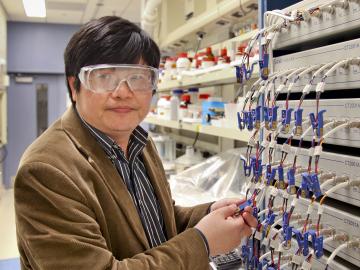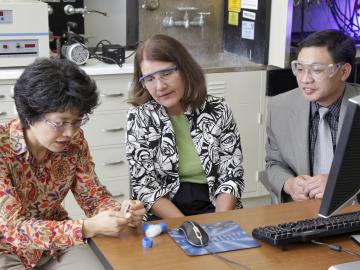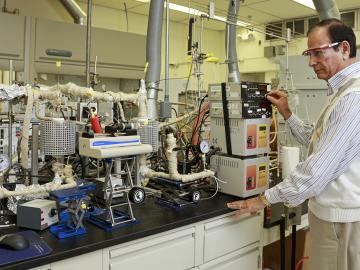Filter News
Area of Research
- (-) Materials (41)
- Advanced Manufacturing (4)
- Biological Systems (3)
- Biology and Soft Matter (1)
- Building Technologies (2)
- Chemical and Engineering Materials (2)
- Chemistry and Physics at Interfaces (6)
- Clean Energy (42)
- Computational Chemistry (1)
- Energy Frontier Research Centers (7)
- Functional Materials for Energy (6)
- Fusion and Fission (1)
- Fusion Energy (1)
- Geographic Information Science and Technology (2)
- Isotope Development and Production (1)
- Isotopes (1)
- Materials Synthesis from Atoms to Systems (5)
- Materials Under Extremes (6)
- National Security (2)
- Neutron Data Analysis and Visualization (2)
- Neutron Science (11)
- Nuclear Science and Technology (6)
- Quantum Condensed Matter (2)
- Reactor Technology (1)
- Supercomputing (20)
- Transportation Systems (2)
News Type
Media Contacts

A collection of seven technologies for lithium recovery developed by scientists from ORNL has been licensed to Element3, a Texas-based company focused on extracting lithium from wastewater produced by oil and gas production.

Electric vehicles can drive longer distances if their lithium-ion batteries deliver more energy in a lighter package. A prime weight-loss candidate is the current collector, a component that often adds 10% to the weight of a battery cell without contributing energy.

Sheng Dai of the Department of Energy’s Oak Ridge National Laboratory has been named to a list of the most highly cited researchers in the world. Thomson Reuters Highly Cited Researchers is an annual list that recognizes some of the world’s leading


The Department of Energy's Oak Ridge National Laboratory and Solid Power Inc. of Louisville, Colo., have signed an exclusive agreement licensing lithium-sulfur materials for next-generation batteries. The company licensed a portfolio of ORNL patents relating to lit...


Researchers at the Department of Energy’s Oak Ridge National Laboratory have received six R&D 100 Awards, increasing the lab’s total to 193 since the award’s inception in 1963. The competition, sponsored by R&D Magazine, recognizes advances in the nation’s ...

The Department of Energy’s Oak Ridge National Laboratory, FCA US LLC, and the foundry giant, Nemak of Mexico, are combining their strengths to create lightweight powertrain materials that will help the auto industry speed past the technological

A new study from the Department of Energy’s Oak Ridge National Laboratory explains the mechanism behind a technology that converts bio-based ethanol into hydrocarbon blend-stocks for use as fossil fuel alternatives. Scientists have experimented for decades with a cl...





